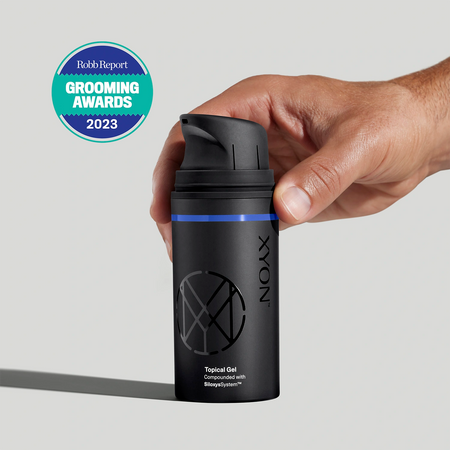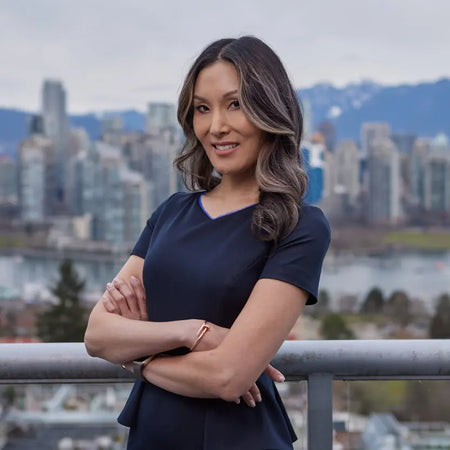If you’re taking finasteride for hair loss, it can be alarming when you suddenly experience increased hair loss. This shedding is more common than you think and isn’t necessarily a cause for concern. In fact, this shedding can happen with any hair loss treatment and is not unique to finasteride.
In this article, we’ll focus on finasteride and talk about what finasteride shedding is, when to expect finasteride shedding and what you can do if you’re experiencing shedding while taking a hair loss treatment. Dr. Han, a board-certified dermatologist and XYON’s medical director also weighs in to give her expertise on the subject.
Can finasteride cause shedding?
Finasteride shedding refers to an unexpected increase in hair loss that begins shortly after starting finasteride treatment. If you’re experiencing this, don’t panic. It’s a perfectly normal reaction to starting this medication and is not to be confused with a true drug intolerance or allergy. It’s actually related to changes in the hair growth cycle, so rest assured that this doesn’t mean your pattern hair loss is all of a sudden getting worse.
Unlike pattern hair loss, shedding associated with finasteride treatment tends to affect the entire scalp and not just the areas where there is visible thinning (e.g. the hairline or crown of the head). Additionally, hair loss is restricted to the scalp and does not occur anywhere else on the body.


Shedding while on hair loss treatment? You're not alone.
XYON's topical finasteride resets the hair growth cycle, making room for stronger, more resilient hair growth.
Why does finasteride cause shedding?
Finasteride does not directly cause shedding. Instead, it’s believed to be because of the effects it has on androgen (male sex hormone) levels. Since finasteride is a DHT-blocking drug, it lowers the concentration of DHT at the scalp, which alters the hair growth cycle. The hair follicles spend more time in the active growth phase and the time between successive growth cycles decreases (van Neste et al., 2000), but for this to happen, the cycle of hair follicles will shift. This involves the existing hairs being pushed out to make room for new hairs to grow.
Dr. Han explained this concept further:
Shedding is related to resetting the hair cycle in the follicles to allow for new growth. So when you start a new treatment, hairs may shift into the telogen (resting) phase, where they are programmed to shed. This is not unique to finasteride and it can occur after starting any hair loss treatment.
The initial shedding can often cause panic, but it’s important to keep taking your finasteride and push through this initial stage. Hair regrowth on finasteride can take some time, but consistency with your medication will give you the best chance when it comes to improving your hair loss.
When does finasteride shedding start?
Shedding on finasteride doesn’t happen to everyone, so you might be wondering how long it will be until you know that you’re in the clear?
In most cases, increased shedding can happen as early as within the first month of beginning hair loss treatment. In other instances, it may take up to two or three months for the individual to notice some increased hair loss. But bear in mind that this varies from person to person, so it’s impossible to give a precise timeline.
Generally speaking, if you haven't experienced hair shedding within the first 4 months of taking finasteride, it’s unlikely to happen at all. Should any shedding occur beyond this time period, other causes of shedding should be investigated for.
How long does finasteride shedding last?
The good news about this kind of shedding is that it’s typically self-limiting and resolves with time. By the sixth month of treatment, most patients see resolution of treatment-related shedding, but shedding can certainly stop earlier. By this time, many will find that any hair lost during the initial shedding stage has at least been replaced.
However, if hair shedding continues long-term, it may be necessary to consult your doctor to determine whether there may be some other underlying cause for your hair loss. Most people shed around 50-100 hairs per day during a normal hair growth cycle (Dhurat & Saraogi, 2009), so if you’re consistently shedding more hair than this every day, you should speak to your doctor.
Can I prevent shedding on finasteride?
No, unfortunately there’s very little you can do to prevent shedding on finasteride. But remember that it’s not a guarantee and you may not experience any shedding at all.
For those who do experience shedding in the initial stages of treatment, the best thing to do is continue to take your medication as normal. It can feel frustrating to take a medication when it seems to be doing the opposite of what it’s intended to do, but try to look at it as a sign that new hair growth is coming.
Whilst finasteride shedding is unpredictable, Dr. Han recommends the following to her patients:
Eating a well-balanced diet with recommended protein intake, taking steps to reduce stress and maintaining overall good health are all necessary to maintain healthy hair. You should also aim to minimize excessive hair care products, heat and chemicals being applied to the scalp, particularly if you are worried about finasteride shedding.
Finally, making sure your scalp is healthy using products that optimize healthy follicles is paramount, so look for ingredients that help to boost growth, exfoliate the scalp and strengthen the hairs.
As Dr. Han mentioned, incorporating supportive hair growth ingredients into your routine is a great way to stay proactive during your treatment. You might consider ingredients such as rosemary oil and ginseng root which are proven to support your hair follicles by enhancing blood circulation and countering natural sources of damage, including UV rays (Choi, 2018). You can find these and many other beneficial ingredients in our DHT-Blocking Shampoo and Conditioner, which have been intentionally formulated to serve as the perfect supportive products, alongside your hair loss treatment.
How can I optimize my hair growth while taking finasteride?
We asked Dr. Han if she had any further advice on how to get the most out of your finasteride treatment. She reiterated that consistency is key, even throughout the initial shedding phase, adding:
Hair growth takes time and patience, so keep at it. If you see shedding, try not to panic as this tends to be temporary. Finally, use complementary products that can help boost the results by selecting ingredients that target your area of concern; whether it’s dandruff, hair loss, or breakage.
If you’ve been taking finasteride for 6-months but haven’t quite seen the results you were hoping for yet, don't be discouraged. Research has shown that the maximum hair growth benefits with finasteride are seen after 1-2 years of starting treatment (Shin et al., 2018). It’s important to stick with your treatment and remember that just because you don’t yet have any visible improvements, your treatment is likely working on the hair follicles beneath the surface.
Takeaway
It’s normal to experience some hair shedding when you first start taking any hair loss medication, including finasteride. Initial shedding is not something to be concerned about and is actually a sign that your hair follicles are entering a new hair growth cycle. So, it’s important to stick with your treatment and keep taking your medication, as ordered by your doctor because hair growth can take some time and patience. If you are experiencing shedding for a prolonged period, you may need to speak to a specialist to ensure there are no other underlying causes for your hair loss.
References
Choi, B.Y. (2018). Hair growth potential of ginseng and its major metabolites: a review on its molecular mechanisms. International Journal of Molecular Sciences, 19(9), 2703. https://doi.org/10.3390/ijms19092703
Dhurat, R., Saraogi, P. (2009). Hair evaluation methods merits and demerits. International Journal of Trichology, 1(2), 108-119. 10.4103/0974-7753.58553
Shin, Y.S., Karna, K.K., Choi, B.R., Park, J.K. (2019). Finasteride and erectile dysfunction in patients with benign prostatic hyperplasia or male androgenetic alopecia. The World Journal of Men’s Health, 37(2). https://doi.org/10.5534%2Fwjmh.180029
Van Neste, D., Fuh, V., Sanchez-Pedreno, P., Lopez-Bran, E., Wolff, H., Whiting, D., Roberts, J., Kopera, D., Stene, J.J., Calvieri, S., Tosti, A., Prens, E., Guarrera, M., Kanojia, P., He, W., Kaufman, K.D. (2000). Finasteride increases anagen hair in men with androgenetic alopecia. British Journal of Dermatology, 143(4), 804-810. https://doi.org/10.1046/j.1365-2133.2000.03780.x





